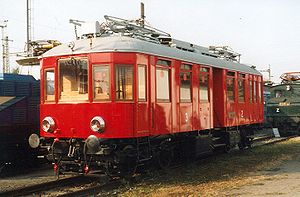kkStB 40.0
| kkStB 40.0 ČSD series M 400.0 |
|
|---|---|
|
Elinka
|
|
| Numbering: | kkStB 40.001–004 ČSD M 400.001–004 |
| Number: | 4th |
| Manufacturer: |
František Křižík , Prague Ringhoffer , Smichow |
| Year of construction (s): | 1903, 1905, 1908 |
| Retirement: | 1937 (400.004), 1961 (400.002), 1974 (400.003) |
| Axis formula : | Bo 'Bo' |
| Gauge : | 1435 mm ( standard gauge ) |
| Length over buffers: | 12,900 mm / 12,900 mm / 13,900 mm / 13,900 mm |
| Fixed wheelbase: | 2,000 mm |
| Total wheelbase: | 9,500 mm / 9,500 mm / 10,500 mm / 10,500 mm |
| Smallest bef. Radius: | 125 m |
| Empty mass: | 18.8 t / 18.8 t / 20.8 t / 20.2 t |
| Service mass: | 22.9 t / 22.9 t / 25.4 t / 25.4 t |
| Friction mass: | 22.9 t / 22.9 t / 25.4 t / 25.4 t |
| Wheel set mass : | 5.7 t / 5.7 t / 6.35 t / 6.64 t |
| Top speed: | 35 km / h |
| Continuous output : | 140 PS / 140 PS / 160 PS / 160 PS 103 kW / 103 kW / 117 kW / 117 kW |
| Driving wheel diameter: | 850 mm |
| Power system : | 1.4 kV direct current 1.5 kV direct current (from 1923) |
| Number of traction motors: | 4th |
| Drive: | Paw camp |
| Brake: | electric short-circuit brake, spindle brake, air brake (only 40.003–004) |
| Train heating: | electric |
| Speedometer: | Housekeeper |
| Seats: | 2nd class: 10/10/8/8 3rd class: 30/30/40/40 |
| Classes : | 2nd / 3rd |
| Particularities: | Horn (only 40.001–002), air pressure whistle (only 40.003–004), luggage room, toilet, electrical lighting (14/14/16/14 lamps), post manipulation room (only 40.003–004) |
The kkStB 40.0 were electric multiple units of the kk state railways (kkStB) for operation on the local Tábor – Bechin railway in Central Bohemia .
history
It was designed by František Křižík , the car body was made by Ringhoffer in Prague . The first two cars (40.001 and 002) were built in 1903. In 1905 and 1908 two more cars were purchased from the same manufacturers (40.003 and 004). The last delivered wagons differed in details from the first delivered ones (see table).
The vehicles remained on their original route even after the First World War , ie they came to ČSD after 1918 , which they designated as M 400.001–004 .
Initially, the railcars were operated with the 1.4 kV direct current power system. From 1929 the voltage was switched to the 1.5 kV direct current power system, which also resulted in a conversion of the railcars.
In 1931–1932 and 1937–1938, the railcars were fundamentally rebuilt. Until 1953, they operated both passenger and freight traffic on their main route. The M 400.004 car was retired in 1937.
In 1956, the E 422.0 series locomotives were delivered, which resulted in the M 400.002 (1961) and M 400.003 (1974) cars being retired. The M 400.001 railcar was built on the chassis of the M 400.003 and renumbered.
In 1971 it was subjected to further workshop repairs, with a new driver's desk, a new braking system, a new headlight and new pantographs, which gave the vehicle its historic appearance. Since then, it has been used regularly on its main route as an operational museum vehicle of the National Technical Museum in Prague .
See also
literature
- Directory of the locomotives, tenders, water cars and railcars of the kk Austrian State Railways and the state-operated private railways as of June 30, 1917 , 14th edition, published by the kk Austrian State Railways, Vienna, 1918
- Karl Gölsdorf: Locomotive construction in Old Austria 1837-1918 , Slezak publishing house, Vienna, 1978. ISBN 3-900134-40-5 .
- Johann Blieberger, Josef Pospichal: Encyclopedia of the kkStB traction vehicles, Volume 4: Series 83 to 100, narrow-gauge and non-steam-powered types. bahnmedien.at, 2011, ISBN 978-3-9502648-8-3 .
